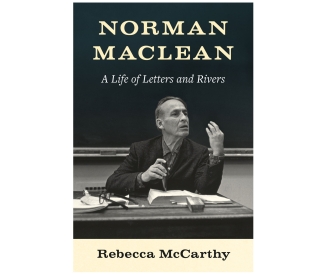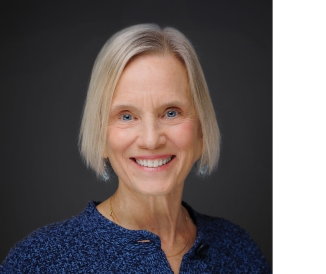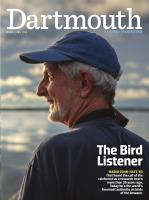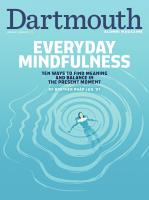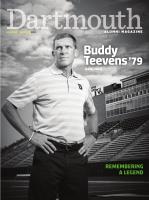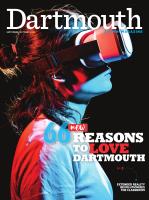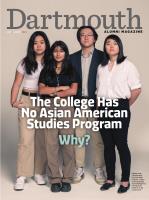
A Man of Letters
It was fall term a quarter-century ago, and Christopher Warren was sitting in a Wilson Hall classroom transfixed by professor William Spengemann’s critiques of 19th-century American poetry. “I never knew,” Warren says, “that one could think so deeply about so few words.”
Today Warren is an English professor himself, at Carnegie Mellon University. He’s an expert on Elizabethan literature and a pioneer in the emerging field he calls “computational bibliography.” English poet William Blake could “see a World in a Grain of Sand,” but Warren, using advanced computer forensics, can see a world in tiny pieces of damaged, degraded, or broken type in early modern publications.
His research, known as the Print and Probability project, has uncovered the identity of 17th-century printers who published two of the main intellectual sources of the Enlightenment, John Locke’s Two
Treatises of Government and the first English translation of Baruch Spinoza’s
Theological-Political Treatise. In the course of these discoveries, Warren has provided new insights about an age when writers and printers toiled amid fear that their works would be judged unacceptable by the monarchy or the church, exposing them to censorship, retribution, and even imprisonment or execution. For that reason, the identity of the printers of scores of books, pamphlets, broadsides, and newspapers has been shrouded in secrecy for centuries.
“There’s a vast world of cultural production whose origins remain incredibly murky,” Warren says.
Until now. By examining and modeling scores of printed works—their fonts, type pieces, paper, inking, and page imposition—Warren and his colleagues find the literary equivalent of fingerprints in important editions. The individual evidence of type, which was manufactured using a fragile mix of tin, antimony, and lead and therefore easily damaged or broken, can become markers of a particular print shop.
The literary detective work requires identifying small elements in type from a time when each letter, and even spaces, were set individually and by hand; finding matches in other works; and tracing them to individual print shops. Even with computer assistance, it is slow, frustrating work.
One of their discoveries: The Locke and Spinoza works, carrying the exact same qualities and flaws of type, were produced within months of each other in late 1689 to early 1690 by Robert Everingham, an otherwise obscure printer in Restoration London whose side hustle was publishing controversial books.
One of the key elements in the discovery was finding a corruption in the character of an upper-case “L” with a flaw in the lower leg of the letter that split the glyph, much the way the Cape Cod Canal splits the peninsula that sticks out between Cape Cod Bay and Buzzards Bay. This is a high-tech version of the forensic work at the center of the Cold War-era Pumpkin Papers contretemps, when stolen confidential documents were determined to have been typed on Woodstock typewriter number N230099, which was owned by Alger Hiss, accused in 1948 of spying for the Soviet Union.
“Carnegie Mellon is the perfect place for a major data project for the digital humanities,” says David Scott Kastan, an expert on the plays of Shakespeare who taught at Dartmouth from 1974 to 1987. “It is the kind of wonderful nerdy project whose payoffs are never obvious in advance, but almost always something consequential inevitably pops up.”
Here’s something else that popped up: For centuries no one knew for sure who printed Shakespeare’s Fourth Folio, a collection of the Bard’s plays that appeared in 1685. Employing computer shoe leather and their signature software, Warren and his colleagues have identified Everingham as one of the printers.
Why is this sort of thing important? Today we care about what people are saying in print and the public square of the Internet, but we also care about the platform—is the source The New York Times, for example, or Fox News?—on which they are saying it. Similarly, the identity of the platforms that have provided us with many of the most significant ideas and arguments of Western thought is revealing and noteworthy, if only because of the risk printers took in bringing them forth.
“This is a time when, in contemporary life, we care about who actually does the work,” Warren says. “In the film Hidden Figures we learned who actually was doing the important calculations for NASA. It’s natural and important that we recognize the work that went into books such as the Fourth Folio, Milton’s Areopagitica, and Locke’s Two Treatises.” Print and Probability receives funding from the National Endowment for the Humanities and the National Science Foundation.
Warren, who earned his Ph.D. in early modern literature from Oxford, lives in Pittsburgh’s Squirrel Hill neighborhood with his wife, landscape architect Julie Kachniasz ’00, and their three children. He joined the Carnegie Mellon faculty after teaching at his alma mater, Gonzaga College High School in Washington, D.C., St. Anselm’s Abbey School in Washington, and the University of Chicago.
At Carnegie Mellon, where he is associate head of the English department, Warren teaches courses in data stories, digital humanities, Milton, Shakespeare, and Renaissance poetry.
“Chris is an exemplary humanist,” says Richard Scheines, dean of Carnegie Mellon’s Dietrich College of Humanities and Social Sciences. “He has done great work on early modern literature and its influence on international law.
“If we had more humanists like Chris, we would not need to be working so hard to ‘save the humanities.’ ”
David Shribman wrote about Buddy Teevens ’79 in the November/December issue of DAM.

